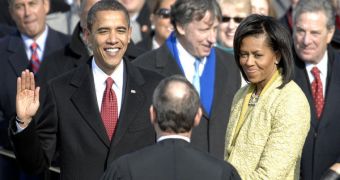International Space Station (ISS) commander Michael Fincke, joined by crew member Sandra Magnus, the mission's current flight engineer, watched president Barack Obama's Inauguration Ceremony from the relative comfort of the orbital station, which currently hovers at 354 kilometers (220 miles) above Earth's surface. Fincke, who went onboard the ISS in October, said he was happy he could watch the transmission, and sent Obama a congratulation message via the mission control center.
"Congratulations on a new president and a new administration," he told space flight instructors, after Obama was officially sworn into position by Chief Justice of the United States John G. Roberts Jr., in Washington, DC. "The next best thing to being in the parade will be to watch it from the comfort of our own space station," he added.
The astronauts were not able to watch the entire broadcast live, because the ISS kept orbiting the planet at high speeds, so the signal could only arrive intermittently. However, the Mission Control Johnson Space Center in Houston kept sending the live feeds every time the station was able to receive it.
"The activities today, as much as possible, were being uplinked live. It will also be recorded and uploaded later so they can look at it then," Kyle Clem, a NASA spokesman, who said that the two crew members on the ISS, alongside with Russian colleague Yury Lonchakov, had the possibility to view the Inaugural Parade as often as they could take a break from the large volume of work they had to put on the station daily, explained yesterday.
Fincke also voted from space for last year's presidential elections, due to the fact that legislation in Houston, Texas allows people in orbit to exercise their constitutional right. Magnus joined the commander in November, replacing NASA astronaut Greg Chamitoff, who returned to Earth onboard the Endeavor space shuttle.
Endeavor's crew participated at the festivities, marching with a new lunar prototype devised by the American space agencies for future attempts to reach the Moon.

 14 DAY TRIAL //
14 DAY TRIAL //